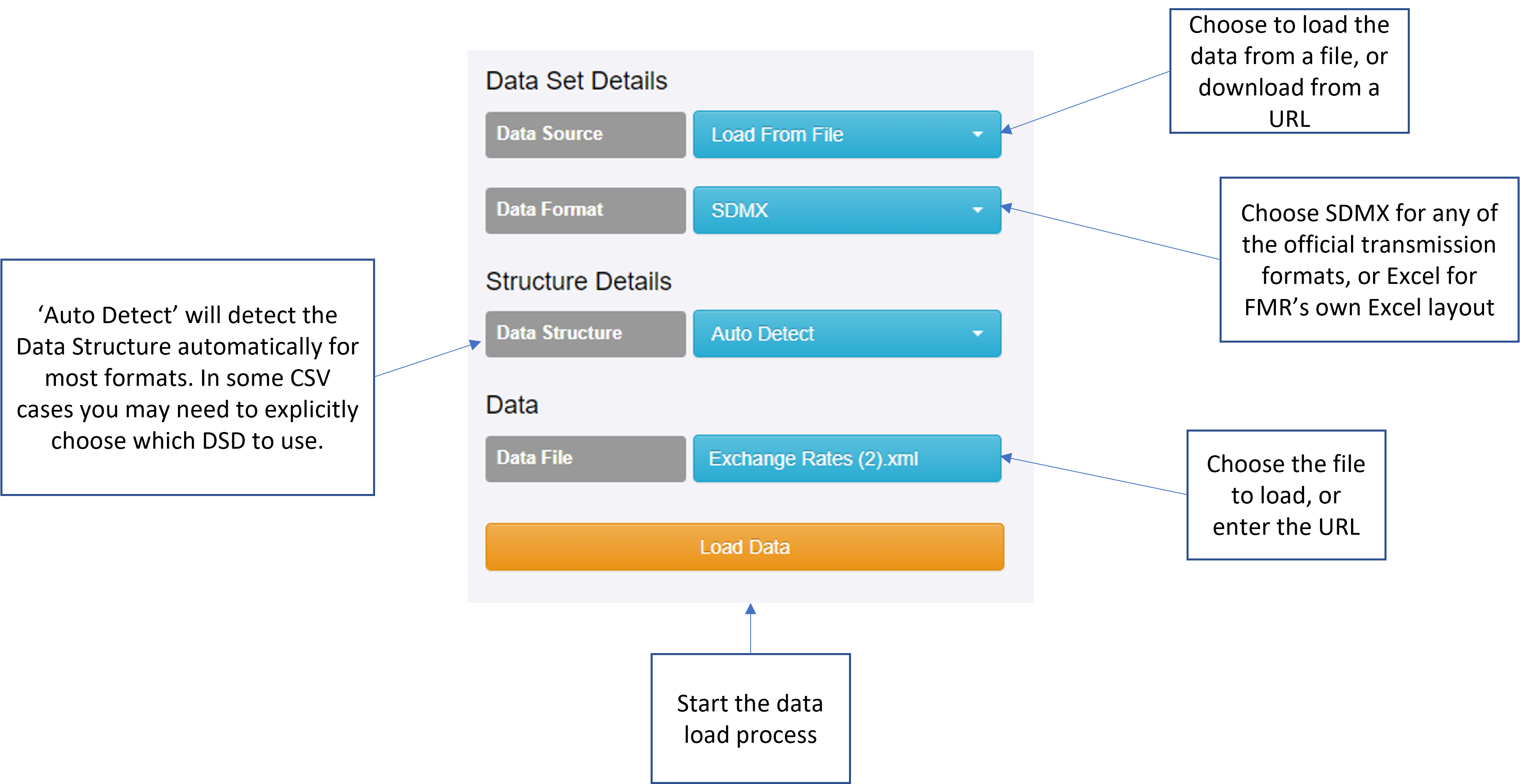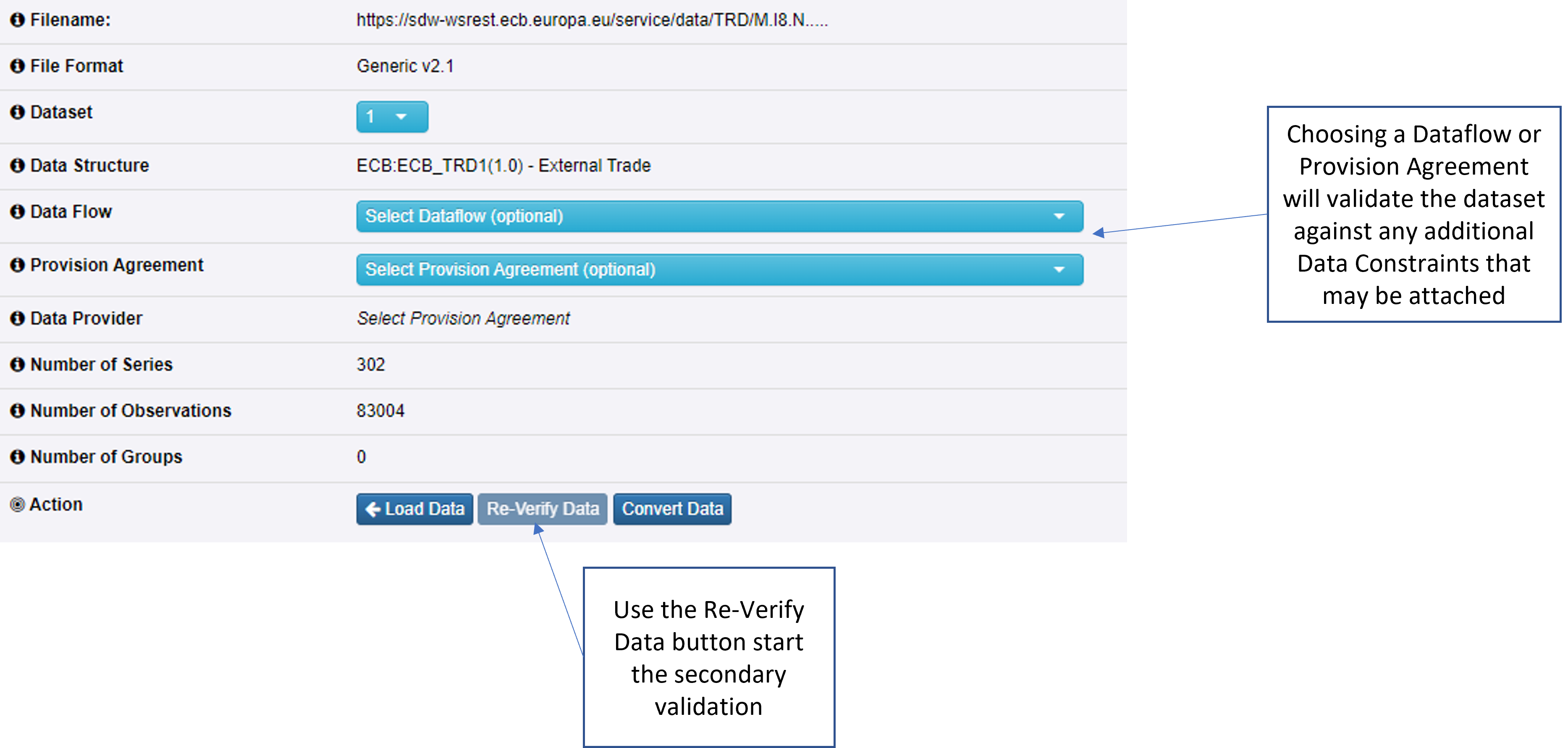Unit 06 Interactive data conversion using the FMR user interface
Introduction
SDMX datasets can be converted interactively between transmission formats using the Convert Data function in FMR’s web user interface.
The interactive data conversion workflow
Conversion of an SDMX dataset follows a defined worflow that starts with loading the data from either a file or a URL.
Load data
option
on menu )) --> A A(Load data) --> B(Validate data) B --> C{Map data?} C -->|no| D(Download data in selected format) C -->|yes| E(Choose mapping) E --> F(Download data in selected structure and format) class A flowHighlight class B flowBox class C flowBox class D flowBox class E flowBox class F flowBox class 0 flowBox

Data Source
Start by choosing where to load the data from.
- File: an XML, JSON, CSV, EDI or Excel file on disk
- URL: a URL which can be either be a static SDMX dataset on a web server, or an SDMX REST API data query for instance https://sdw-wsrest.ecb.europa.eu/service/data/EXR/M..EUR.SP00.A
The Data Format
The Data Format defaults to SDMX which refers to any of the standard SDMX transmission formats previously discussed.
Choose Excel for FMR’s own Excel format.
CSV can be used when loading CSV data that is not in the standard SDMX format.
Data Structure
FMR will automatically detect the source dataset’s DSD for all SDMX formats and FMR Excel.
You will need to explicitly choose the DSD, only when working with CSV that does not have columns for the Dataflow, DSD or Provision Agreement. Clicking the Data Structure dropdown reveals a list of all DSD’s in your FMR’s structural metadata registry from which to pick.
FMR must hold a copy of the Data Structure Definition (DSD) for the dataset being loaded - the DSD is needed to interpret and validate the source data.
If the DSD is missing FMR will report a Bad Reference error explaining that the dataset being loaded references an unknown structure. Resolve the problem by loading or manually creating the DSD in FMR.
Data File or Data URL
Choose the file to load.
- Click on the blue box to select the file using File Explorer (Windows) or Finder (Mac)
- Drag and drop the file onto the blue box
Validate data
option
on menu )) --> A A(Load data) --> B(Validate data) B --> C{Map data?} C -->|no| D(Download data in selected format) C -->|yes| E(Choose mapping) E --> F(Download data in selected structure and format) class B flowHighlight class A flowBox class C flowBox class D flowBox class E flowBox class F flowBox class 0 flowBox
FMR automatically validates the dataset agaist the DSD as soon as it is loaded.
Nine separate validation rules are applied and a report is returned showing whether each rule has passed or failed. In the example below, a representation error has been detected because the dataset contains a code that is not in FMR’s copy of the relevant Codelist.
- Goto the FMR cloud sandbox Load Data Page: https://fmr.sdmxcloud.org/FusionRegistry/data/load/data-load.html
- Select Load From URL for the data source
- Copy the following URL which is a selection from the ECB’s External Trade dataset in SDMX-ML 2.1 Generic format:
https://sdw-wsrest.ecb.europa.eu/service/data/TRD/M.I8.N.....UVX - Past the URL into Data URL box and click Load Data
Validation agaist Dataflow and Provision Agreement Data Constraints
Loaded data can be further validated against a Dataflow or Provision Agreement. This secondaray validation checks whether the dataset complies with any additional Data Constraints that may be attached to the Dataflow, Provision Agreement or both.

Map data
option
on menu )) --> A A(Load data) --> B(Validate data) B --> C{Map data?} C -->|no| D(Download data in selected format) C -->|yes| E(Choose mapping) E --> F(Download data in selected structure and format) class C flowHighlight class A flowBox class B flowBox class D flowBox class E flowHighlight class F flowBox class 0 flowBox
FMR’s data conversion function optionally allows loaded datasets to be transformed to different DSDs if the necessary SDMX Structure Maps have been defined. Click Convert Data and select the required Structure Map from the list provided on the Download Data popup window.
Download data in the selected format
option
on menu )) --> A A(Load data) --> B(Validate data) B --> C{Map data?} C -->|no| D(Download data in selected format) C -->|yes| E(Choose mapping) E --> F(Download data in selected structure and format) class 0 flowBox class A flowBox class B flowBox class C flowBox class D flowHighlight class E flowBox class F flowHighlight
Click the Convert Data button to complete the conversion process by downloading the loaded dataset in the required transmission format.
Data Format is curently always SDMX. Other non-SDMX transmission formats such as Excel or XBRL may be supported in future versions of FMR.
Choose the SDMX format from the Sub-Format list.
Compression The final dataset can be optionally compressed as a Zip file.
Sender Id For some data formats (e.g. SDMX-ML or SDMX-EDI) the header section contains the sender id. This field can be used to set the value the sender id will take.
Tips and points to note
FMR will often allow datasets to be converted and downloaded in the required format despite validation errors being reported. Only critical errors such as structural mismatch between the loaded dataset and the DSD will block conversion.
Consider using the Compression option when converting to more verbose formats such as SDMX-ML (XML).
Loaded datasets are held in temporary storage for up to 15 minutes before being discarded. You’ll need to re-load the data if the converson and download process is not completed within that time.
Recap
- SDMX datasets can be converted interactively between transmission formats using the Convert Data function that can be found in the web user interfaces menu bar.
- Datasets can be loaded from file or directly from a URL.
- FMR automatically validates loaded a loaded dataset against its DSD copy of which must already be present in FMR’s structural metadata repository.
- Loaded datasets can also be optionally validated against a Dataflow or Provision Agreement to check for compliance with any additional Data Constraints.
- Loaded datasets can be optionally mapped to different DSDs provided the necessary SDMX Structure Maps are in plance, and downloaded in any of the standard SDMX formats
In the next unit
The next and final unit looks briefly at FMR’s ‘quick convert’ function for converting datasets to SDMX-ML 2.1 Structure Specific